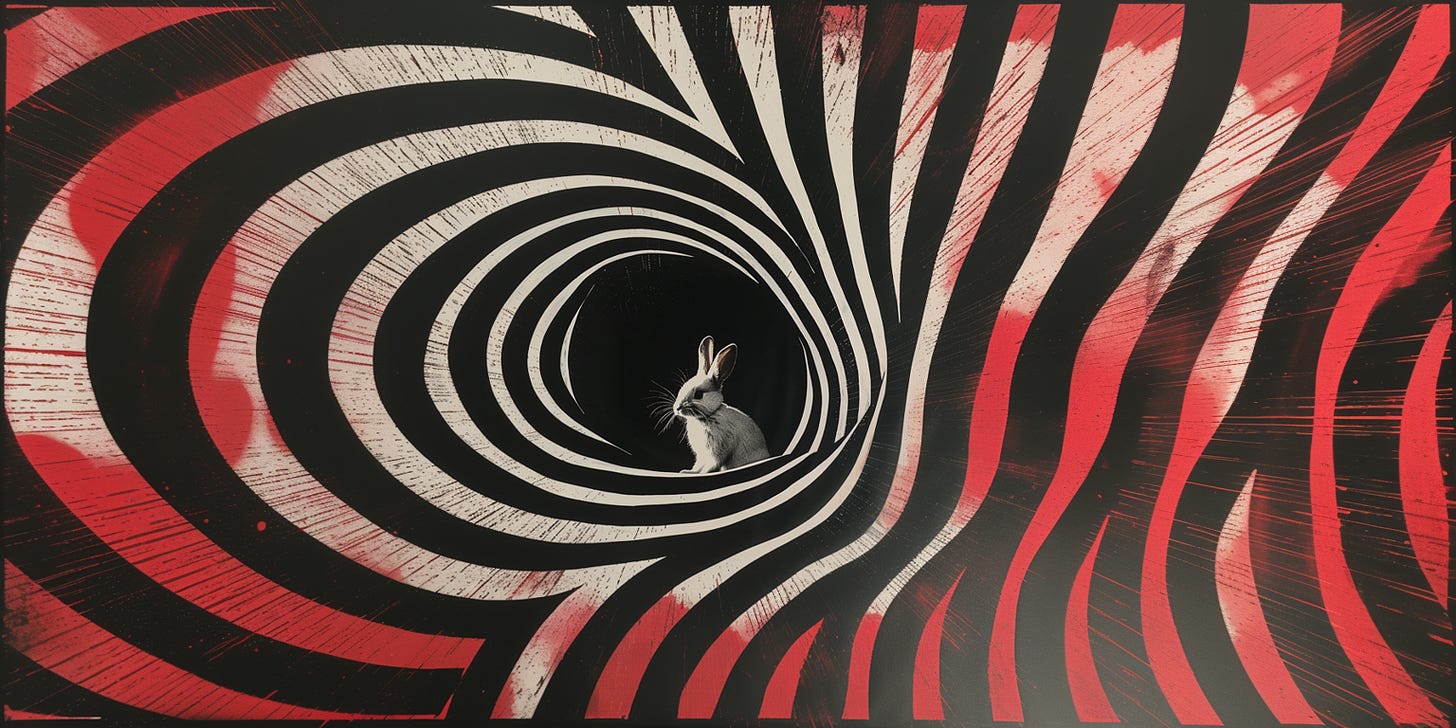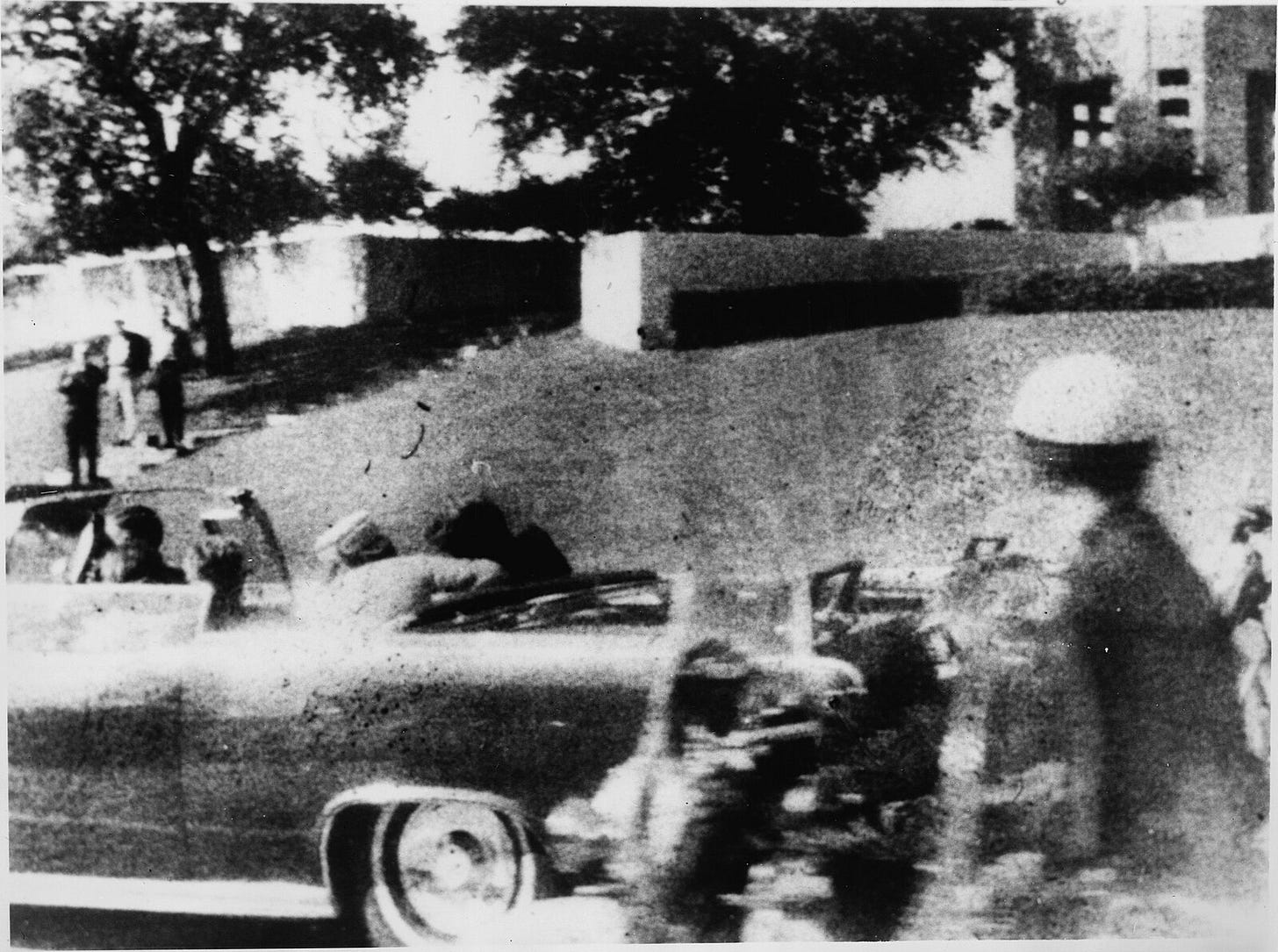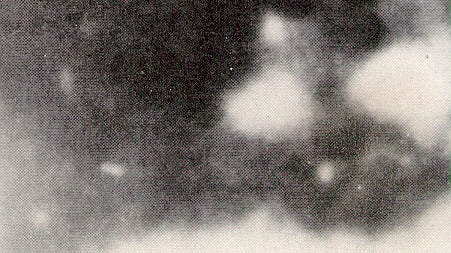PART 1: Follow the White Rabbit
Shoulder to shoulder, peering into the plastic tray, we wait. The square of photo-paper, pale pink under the red light, is still blank. Beneath the surface of the chemical bath, the paper darkens. The square is overtaken by shadowy impressions. Formless at first, their structures unfold with every tick of the timer.
I look at Jack whose eyes are fixed on the developing image. R-r-r-r-ing! Jack dips the tongs into the liquid and carefully extracts the photograph from the bath. Soundlessly, he slips the sheet into the stop bath. We both lean over the tray, gazing intently at the vague suggestions of forms staring back at us.
Do either of us have any sense of the countless hours we’ll pass looking at this very photograph? Our eyes developing fluency in its secret language?
I squint my eyes, gripped by recognition of a form. Or the suggestion of one. A face? That’s an ear! Hair. A shoulder. The mouth, obscured by a blast of white. I’m shouting my thoughts as fast as they register.
Pointing at the spectre, my eyes target another shock of white below the shoulder. Small. On the chest. Like a badge. A police badge?
My fictional account of the initial examination of the photo-enlargement of the Mary Anne Moorman polaroid by researcher Gary Mack and photo-technician Jack White.
Moorman snapped the polaroid 1/6th of a second after the fatal bullet struck President JFK in the head. It’s the single published photograph that captured a view of the grassy knoll during the shooting.
After intensive scrutiny of a copy of Moore’s polaroid and enlargements of a small section of the image, Mack discovered “Badge Man,” one of three figures described by Mack and White as standing on the Grassy Knoll at the time of the murder and captured on film. Badge Man, Mack and White allege, is the second gunman who fired the fatal shot while disguised in a police uniform.
JFK’s assassination in Dealey Plaza on November 22nd, 1963 and the subsequent findings of the Warren Commission remain heavily contested by investigative journalists and conspiracy theorists alike.
Entering the Rabbit Hole
There’s something magnetic about conspiracy theories - those raw attempts to make sense of shocking, mind-boggling scenarios that defy straightforward explanation. The urgent pull of a mystery yet to be unravelled. And the repelling quality of a facile explanation put forth by the media. Slick, like it was laid out on a silver platter, stripped of nuance. Flat.
Why exactly can conspiracy theories be so compelling? What is it about them that can send logical and reasonable human beings scuttling down strange, winding rabbit holes deep beneath the surface of accepted belief?
Over the following pages, we’ll do some digging into the psychological needs that conspiracy theories potentially satisfy, as well as strategies to prevent us losing ourselves in their labyrinthine tunnels.
We’ll also discuss the manner in which governments and corporations can use the label “conspiracy theory” as a smoke screen to limit public scrutiny of real conspiratorial activity.
It’s worth acknowledging that many explorations of conspiratorial thinking take for granted that conspiracy theories are inherently bogus. This is simply untrue. Yes, undoubtedly many of the conspiracy theories that infest the realm of ideas are unhinged from reality and represent fantastical expressions of fear and delusion. But not all of them.
Before we dive any deeper, let’s define the concepts that we’ll be exploring.
What is a Conspiracy?
From Wikipedia:
Conspiracy
A conspiracy, also known as a plot, ploy, or scheme, is a secret plan or agreement between people (called conspirers or conspirators) for an unlawful or harmful purpose, such as murder, treason, or corruption, especially with a political motivation,[2] while keeping their agreement secret from the public or from other people affected by it.
What is a Conspiracy Theory?
Conspiracy Theory
A conspiracy theory is an explanation for an event or situation that asserts the existence of a conspiracy by powerful and sinister groups, often political in motivation,[3][4][5] when other explanations are more probable.[3][6][7] The term generally has a negative connotation, implying that the appeal of a conspiracy theory is based in prejudice, emotional conviction, or insufficient evidence.[8] A conspiracy theory is distinct from a conspiracy; it refers to a hypothesized conspiracy with specific characteristics, including but not limited to opposition to the mainstream consensus among those who are qualified to evaluate its accuracy, such as scientists or historians.[9][10][11]
Some key components of a conspiracy theory include:
• A belief that powerful parties are covertly colluding behind the scenes
• Claims of intentional deception and/or the suppression of information from the public
• Rejection of explanations and narratives put forth by mainstream sources
• The proposition of alternative explanations, for example, based on circumstantial evidence.
Reflection Questions:
• What are some conspiracy theories that you have personally come across?
• Focusing on one example, what was your initial response to encountering the theory? For example, scepticism, fear, discomfort, or even annoyance?
• Do you or anyone you know (friends, family, or colleagues) actively engage with conspiracy theories? If so, how are you or they perceived by those who don't share similar interests or beliefs?





